MiG-21 Fishbed and MiG-21 Lancer
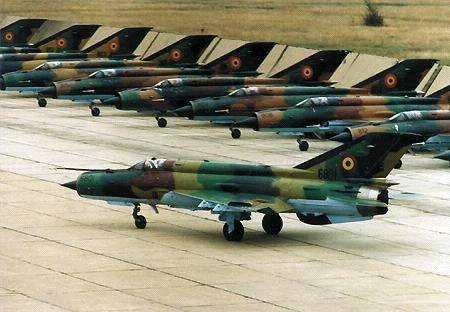
86th Air Force Base, located at Borcea-Fetesti
MiG-21 LanceR A, the ground attack version, being parked on a platform. The 86th AFB is home to two LanceR A/B/C squadrons. The 861st "Titmice" sq. handles air superiority, while the 862nd is responsible for ground attack.
The motto of the 861st sq. is "SINE ERROR": latin for "without any errors".
|
MiG-21 Fishbed
The MiG-21 is a story of success from the Soviet aircraft designers. It is one of the most longevive and versatile fighters ever built, still in active service in no less than 25 Air Forces worldwide. Many of the units still in usage today have enough resource left to stay that way for years to come, and many countries have expressed the wish or have already started to extend the resource and upgrade their existing fighters, therefore maintaining this flying piece of history where it belongs - up in the air.
MiG-21 is a supersonic Mach 2, single engine jet fighter.
Designed in the 1950s and built during the 1960s, 70s and 80s, the MiG-21 has a variety of versions and has been built in over 10,000 units. Few fighters have been built in such huge numbers, especially after World War II.
Although the MiG-21's First Flight was in 1955 (the first active service unit of the series), it has been in use ever since.
 | Fortele Aeriene Romāne
MiG21 Fishbed tail 6946 flown by lt-col. Cmdr. Doru Davidovici, 1989 |
MiG-21 Fishbed Technical Data
Dimensions
wingspan: 7.15m
length: 15.76 m
height: 4.2 m
Weight
empty: 5,200 kg
max: 8,745 kg
|
Engine and Performance
Tumansky RD-13-300 engine with 6600 kg of thrust at full augumentation
Max speed (H=11 km) - 2250 km/h
Ascending speed: 295 m/sec
landing speed: 270 km/h
combat ceiling - 18000 m
Range - 900 km
|
Weapons
single GSh-23L 23 mm cannon, with 200 armour piercing rounds
1,000 kg payload, including air-to-air missiles, air-to-ground missiles, rockets, bombs, fuel tanks, ECM pods
|
MiG-21 Fishbed Photo Gallery
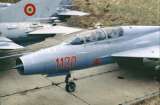 |
 |
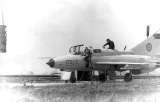 |
 |
"The Old Lady",
MiG 21 Mongol tail 1120, a retired two-seater, Borcea-Fetesti AFB
|
MiG 21 Mongol at landing, flown by the Romanian Air Force Fighter elite pilot, and author, lt-col Cmdr
Doru Davidovici |
MiG 21 Fishbed on ground with lt-col Cmdr Doru Davidovici entering the plane (1989) |
Romanian Air Force MiG21 Fishbed single-seaters cell lead by a RoAF MiG21 Mongol two-seater |
The evolution of fighter aircraft of the past 20 years has meant a huge leap in technology, especially regarding the avionics and weapons systems (flight and navigation systems, target aquisition systems, "surgical" strike capabilities and precision, hostile environment survivability modes), but also in the construction of the airframe or the engines. However, purchasing new fighters can easily suffocate the defence budget of most countries that wish to acquire such formidable weapons. A modern jet fighter can cost anything between 25 and 30 million dollars (MiG29, 50 to 60 million dollars F-16, F-18, Saab JAS-39 Gripen) and 80 to 160 million dollars (F-22 Raptor and Eurofighter2000 Typhoon).
That is why many countries choose to upgrade fighters which are already in service, by fitting them with up to date electronics and radars. As such, they can operate modern weapons platforms for a much cheaper price.
---
From all of the fighters made by the Soviet Union, MiG21 represented a formidable opponent during the conflicts of the 60s and 70s (the ones between India and Pakistan in 1965 and 1971, the Vietnam war, the Arab-Israeli wars of 1967 and 1973), but with the appearance of the new fighter generation represented by F-16, F-18 and MiG-29, the MiG-21 was outperformed and outdated, especially regarding the radio-electronic and digital avionics which handle the flight control systems, firing systems, navigation systems, etc.
Altogether, 10,158 MiG21 fighters were built in three factories throughout the former Soviet Union: GAZ-21 Sokol factory from Gorki (Nijni Novgorod), GAZ-1 Znamia Truda from Moscow and GAZ-31 Gheorghi Dimitrov (currently located in Georgia). Added to these, are the fighters produced under licence in Czehoslovakia, India, China, as well as the Chinese J copies.
The first versions to be built, MiG21 F-13, MiG21 PF and MiG21 U were already retired from active service by the majority of their users except only the Third World countries, but more recent versions, built especially after 1970 are still in active service and they still have a sufficient flight resource, which allows their maintainence in active service until the year 2010.
The MiG21M, MiG21 MF (designated Fishbed J by NATO), MiG21bis (designated Fishbed L) single-seaters and the MiG21UM (designated Mongol B) two-seater make a total of 4500 aircraft, made in the Soviet Union, India and China, which are currently (january 1999) in service in over 35 countries and which are waiting for an update.
As well as in other countries from the ex-Eastern Europe block, the MiG21 built for Romania is the backbone of the Romanian Air Force. In february 1962, a first squad was equiped with 12 MiG21 F13s, (designated by NATO as Izdelie 74 or Fishbed B) on the Deveselu airfield. The second squad equipped with MiG21 F13s (15 august 1963) was located on the Mihail Kogalniceanu airfield. This version was retired from active service between 1975-1976, and the MiG21 F13 was followed by the MiG21 PF (designated Izdelie 76 or Fishbed E), but designated MiG21 RFM in Romania (arrived in 1965), the two-seater MiG21 U (designated Izdelie 66 or Mongol A, arrived in 1965, 1966 and 1968), MiG21 PFM (designated Izdelie 94 or Fishbed F), but designated MiG21 RFMM in Romania, arrived in 1966, 1967 and 1968, the MiG21M (designated Izdelie 96A), arrived in 1968, MiG21 R (designated Izdelie 94R or Fishbed H), but designated MiG21 C in Romania (arrived in 1968 and 1972), MiG21 MF (designated Izdelie 96F, arrived in 1971) and the two-seaters MiG21 US (designated Izdelie 96F, arrived in 1971) and MiG21 US (designated Izdelie 68, arrived in 1969) and MiG21 UM (designated Izdelie 69, which have entered service beginning from 1971). As well as in most in service jet aircraft, all the MiG21 versions specified upwards, as well as the engines and the additional installations were fixed beginning from 1968 at URA Bacau (later IARv, IAv Bacau, and since 1991 - Aerostar SA).
MiG-21 Lancer
At the beginning of the 1990s, the reduced defense budget due to economic problems in Romania didn't allowed the acquisition of new fighters, but the various recources allowed the upgrading of older aircraft. So the Romanian Air Force had a good solution in updating the existing park of aircraft. In 1992, the Romanian Defense Ministery emitted a request for updating those MiGs to 5 companies:
- MAPO Mikhoyan-Gurevich (Russia) ;
>
- Thomson (France) ;
- GEC Marconi (UK) ;
and Elbit Ltd and IAI Lahavi (Israel).
Since the beginning, the intention was that participating at the upgrading would also be Aerostar SA, who allready had more than 25 years in repairing the MiG21s and the existing facilities. At the end of 1992, Aerostar SA and IAI Lahav begun the work at the functionable mock-up MiG21-2000, which was presented at LeBourget Air Show '93. At the middle of 1993, Elbit Ltd was chosen as an integrator of the updating, and the contracts with the Defense Ministry and Aerostar SA were signed. In the 15th of november 1993 the upgrading contract was authorized. The sellection of Elbit was made due to its experience in upgrading L39s and F5s and due to the high degree of implication proposed to the Romanian aircraft industry (other key-contracts are working in the integrator's facilities, at high-prices).
At a short time after the authorization, the projecting of the new systems begun at Aerostar SA by mixed teams of Israeli and Romanians working with CAD software.
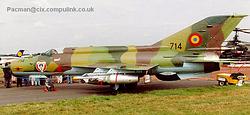
The MiG-21 Lancer 714 prototype displayed at Farnborough in 1996 |
The Program for upgrading 110 of Romania's MiG-21 Fishbeds was named Programul Lancer "D.D." in the memory of the Romanian fighter pilot and author of the 1980s, lt-col Doru Davidovici. Lt-col Davidovici died in the crash of his MiG-21 Mongol in the morning of the 30th of April 1989 on Borcea-Fetesti AFB due to a wrong manoeuvre at the initial landing approach. Doru Davidovici allowed another, younger pilot to land first. When his turn came, an error in manoeuvering plumitted the plane into the ground.
|
In the DD program the MiG-21 was reconfigured in the following versions:
MiG-21 A Lancer
- the single-seat close-air support and ground attack version
The prototype of this version, and actually the first MiG-21 Lancer upgrated in Romania, no 9809, designated before the updating "The Protocole" first flew in the 22nd of august, 1995 for 37 minutes.
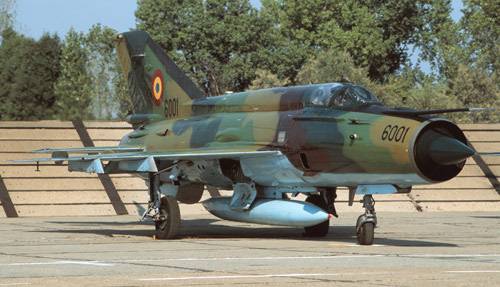 |
This is tail 6001 MiG-21 A Lancer, Mihail Kogalniceanu AFB
...one of the Lancers which participated at the Romanian-French trainings in 1998 and 1999
Tail 6001 crashed in 2002; the pilot did not eject. |
The first MiG-21 LanceR took-off at 14:18 hrs Bucharest time, in the 23rd of august 1995. The first serial model (tail 714) was displayed, both on ground and in the air, at Farnborough 96.
MiG-21 B Lancer
- the two-seater trainer, close-air support and ground attack version
| Twenthe AFB, Holland, 2000
|
|
Expomil 99, Bucharest, oct 1999
|
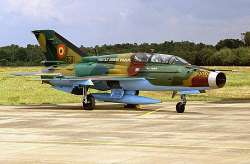 |
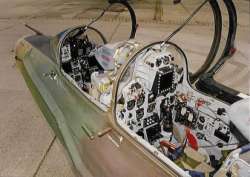
|
|
Photo by Robin Polderman
|
photo: Danut Vlad
|
MiG-21 B Lancer tail 9501 |
click the pictures for the real size version
|
Excellent image of the interior of the MiG-21 B Lancer
|
The prototype of this version (327) had its first flight on the 6th of may, 1996. The aircraft took-off at 16:00 hrs Bucharest Time, and it flew for 40 minutes. The official first flight was on the 8th of may, 1996.
Between the 8th and the 12th of december 1998, the aircraft was shown at Aero India '98 in Bangalore. The two-seater Lancer B has advanced ground-attack capability, completely unexistent in the unupdated Mongol two-seater version. The avionics installed on both Lancer A and B permitts an increase of the accuracy of hitting the targets, due to continuous calculation of the impact point, launching a bomb on re-established coordinates and dive bombing facilities. The ground-attack aircraft are painted in 2xgreen and 2xbrown colors on the extrados and in light blue on
the intrados.
MiG-21 C Lancer - the air superiority version
The prototype of this version, tail 6607, first flew in the 6th of november 1996, a flight which lasted 40 minutes.
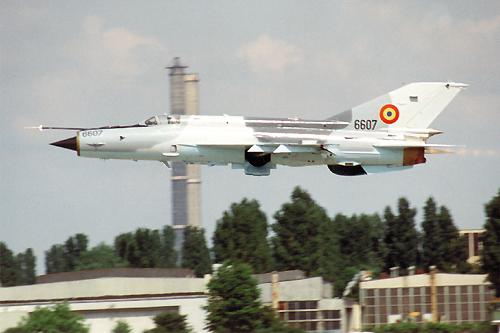
|
MiG-21 LanceR C
first flight
6th of november 1996
Photo by Aerostar SA
(photo via ing. Danut Vlad, Marketing Manager - Aerostar SA)
|
The take-off was at 11:07hrs Bucharest Time, and the official first flight was in the 8th of november 1996. Due to higher precision requirements for the Elbit 2032 radar, a new dielectic cone (radom) was installed, fact observed from the outside by its black color, compared to the green one of the Lancer A.
 |
MiG-21 C LanceR. Notice the new cone
Click the photo for the large version |
The interaction between the radar and the new cone (radom) was tested on a flying IAI Westwind lab, which had the nose modified after the countour of the MiG-21. The maximum distance of the radar's "eyes" is between 60-80km.
Inside view of the Aerostar SA Bacau factory
MiG-21 Lancer 810, the same one which was in the 6 Lancer formation when flying with the two dutch F-16AM Fighting Falcons (tails 365 and 535 from Twenthe AFB) that came to Romania in the spring of 2000, is shown here during maintainence procedures.
|
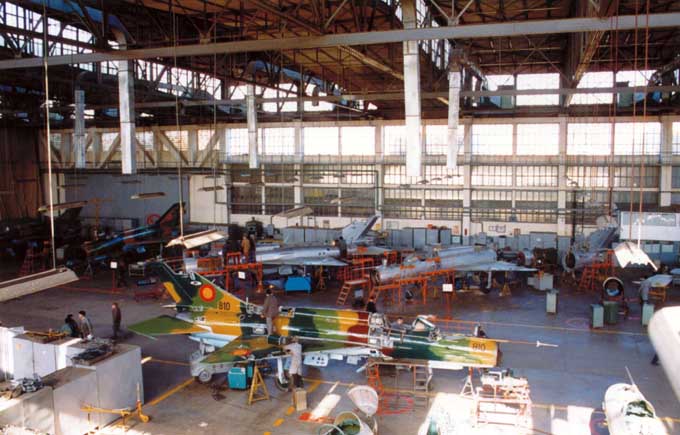 |
This picture does not represent a threat to the National Security of Romania, and therefore it is moral and legal to display it on my website. No classified materials and/or activities are being portrayed here
|
Copyright ©2000 Sorin A. Crāsmarelu
/ photo via Netwalker
|
Lancer C is painted in 3 colors of grey on the extrados and light blue on the intrados.
Lancer A and Lancer C were realized by updating the single-seaters MiG21 M/MF aka Lancer I.
In the unupdated version, MiG21 M/MF was equiped with an RP-21 radar with a reduced range, it could only fire russian missiles and it had limited air-ground capabilities (only unguided russian-made bombs, similar with F-16A which also can not drop smart-bombs).
Lancer B was realized by updating the MiG21 UM two-seater aka Lancer II.
Because half of the MiG21s still in service around the world are MiG21bises, Aerostar SA and Elbit Ltd have updated such an model. The upgraded MiG21bis model is named MiG21bis Lancer III and compared to the previous versions, the MiG21bis is the most advanced MiG21 version in the world.
It has an R-25-300 turbofan, which developes 71kN at afterburner (7,239.9 kgf), and 95kN (9,687.3 kgf) with its superafterburner (ChR), but which can only be held for 3 minutes in a supersonic flight at altitudes between 0 and 4000m (only other planes capable of sea-level supersonic flight I know of are some of the 5th generation fighters), and the fuel load has increased with 190kg compared to the old MF version.
I still have no idea where the MiG-21bis unit came from, since Romania does not have any such aircraft in storage, nor where that MiG-21bis Lancer III is now. If you do, please tell me.
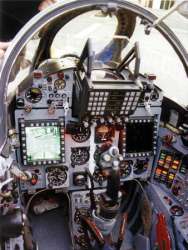
|
MiG-21bis Lancer III
Inside view of the cockpit.
Click the picture for the real size version
|
1030 MiG21bises were built at Gorki, plus other 220 aircraft made in India by licence. Because MiG21bis is not serving in the Romanian Air Force, its updating was made as Lancer III. Lancer III has avionics similar to Lancer C, but installed on an MiG21bis. The MiG21bis Lancer III prototype, no. 165, had it's first flight on October the 6th, 1998, taking-off at 18:20 Bucharest time and flying for 25 minutes. The official flight was in October the 9th, 1998. Before of its first flight, the MiG21bis Lancer III was shown at Farnborough 98.
The first flights of the prototypes were flown by the israeli pilot Yehuda Shafir.
One of the key-elements of the updating is the man-machine interface.
The essential fighting commands are displayed and controlled as a HOTAS system and the equipment is NATO-compatible. A lot of old analogic devices of the old models were replaced with 2 multifunctional displays, 5x5 (12.7x12.7cm) with 20 programable keys, one color (MFCD), used for navigation, for the management of the pylons (SMS - Stores Management System) etc, situated on the left side of the cockpit at all the versions, and one monochrome display (MFD), which presents the radar situation on the Lancer C, but optionally, it can be installed on the other versions too. The aircraft also has a HUD(HeadUp Display) above the control panels, which is an Elop 921 model, and which displays the simbols in 3 modes:A/A for air-air, A/G for air-ground and NAV for navigation. At the base of the HUD is the DED(Data Entry Display), on which the data can be introduced into the system from the keyboard (UPCP - Up Front Control Panel). The data are introduced and displayed in the system by DED. At Lancer B (the two-seater), the front sit has an MFCD and a HUD, and the MFD monochrome display in the back sit repeats the HUD displaying and in the same time insures the relations with the avionics (navigation, map, SMS, tactical situation).
The Integrated Sight Helmet (HelmetUp Display) Elbit DASH(Display and Sight Helmet) displays vital A/A, A/G and NAV information, and in the same time it orientates the missiles' sensors after the pilot's orientation line. The DASH system is much more advanced and precised than the one in use of the MiG29's helmet, while many air force's in the world (including the US Air Force) have not developed yet an similar operational system.
 |
Captain Commander Laurentiu "Kiru" Chirita
MiG-21 Lancer instructor and chief of the RoAF Demo Team in his Lancer cockpit
You can see here both the best helmet in the world until the F-22 will enter in service (2005), as well as some of the MIL STD displays |
The usage of the new systems forced the instalation of 2 MIL STD 1553 B data buses, one for avionics (navigation, radar, airodynamic data computer, data transfer system) and onother one for the SMS(Stores Management System), both controlled by the Elbit MMRC multirole computer. The link between the MMRC and the bariometric take-in PVD7 (The Pitot tube) is insured by the airodynamic data computer. High-precission navigation is insured by an hybrid navigation system (HNS), composed by an inertial system (INS) strap-down Litton 4000, coupled with an GPS Trimble receiver, with usage of data from the ADC bus. The radionavigation system, compatible with the VOR/ILS/DME systems, is an integrated-type one. The original ask-answer system was replaced with an IFF Plessey transporder, compatible with the IFF NATO Mk10 transporder, as dictated by STANAG 41-93. The aircraft is equipped with 2 VHF-UHF AM/FM communication stations with digital modulling. One of the two stations has a freq-loup work mode.
In the old unupdated versions, the MiG21 Fishbed was equipped with a Sirena 3 radiolocation warning device.
Due to the new technology and devices present aboard the upgraded version, Sirena 3 had to be strapped down and replaced with a new Elisra SPS-20 warning system.
Also, a new ECS (climatization control) unit was fitted to the Lancer in order to cool the new avionics (by comparison, the F-22's supercomputer is cooled by liquid nitrogenium).
Each version of the Lancer has a diffrent redesigned cable, electrical and wiring systems.
However throughout all this complicated upgrading, good-old Russian equipment was still maintained in areas where it is still performant and it needs to replacement. Such areas are the ARK-10 radiocompass, the AP-155 auto-pilot and the GS-23L cannon.
MiG21 Lancer can be customized before each mission to better fit its purposes, such as follows:
For ATTACK missions, MiG-21 Lancer can be fitted with an LDP laser-illuminator, which will then guide the LGBs (Laser Guided Bombs), while for
RECON missions the Lancer can be fitted with a photographycal intelligence gatherig device made especially for that mission by Aerostar and Elbit and which is called ARP.
Coming down to WEAPONS SYSTEMS, the MiG-21 Lancer was the first aircraft in the world which had multi-capability weapons pylons built in Romania by Aerostar SA and Elbit Ltd. These weapon pylons have the unique and previously unheard-of capability of being able to attach and operate both eastern as well as western weapons.
Western air-to-air missiles such as the AIM-120C AMRAAM, AIM-9X Sidewinder, AIM-7 Sparrow, air-to-ground missiles such as Maverick, all the smart bombs like GBU 500, 1000 and 2000 lbs LGBs, JDAM 500, 1000 and 2000 as well as dumb-bombs like Mk82 (500 lbs) and Mk83 (1000lbs), Mk84 (2000lbs) and Mk85 can be fitted to and operated by the MiG-21 Lancer.
Eastern air-to-air missiles such as the AA10, AA11, AA12, R-73, R-77 and air-to-ground missiles such as Krypton and others can also be fitted to and operated by the MiG-21 Lancer, together with Russian 250kg, 500kg and 1000kg both dumb as well as smart bombs.
MiG21 Fishbeds can only launch twin-salves of bombs (in pairs), while the MiG21 Lancer can launch a single bomb as well.
Also, the underfuselage pylon is still available, but while at the old Fishbed versions it could only carry a fuel tank, in the Lancer version the pylon can also carry an Mk83 dumb bomb or LDP, ECM or ARP container.
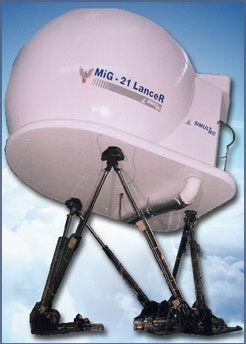 |
MiG-21 Lancer Flight Simulator
For the integration of the avionics pack, two avionics simulators have been built separatly, one by Aerostar and the other one by Elbit. These two set the bases for the build-up of the new Lancer Flight Simulator which is located in Romania at Simultec.
The main MiG-21 Lancer Flight Simulator has been moved to Timisoara AFB in december 2002. It is unknown where the simulator is now, perhaps it could be at Otopeni.
|
The test flights of the three prototypes were done according to the previous scheduled graphic and were flown by a mixed Romanian-Israeli team of pilots lead by Israeli pilot Yahuda Shafir and Romanian Cmdr. Gheorghe Simion.
At the end of 1996, the first MiG21 Lancer fighters have been delivered to the Romanian Air Force, and in the 8th of may 1997 the first full Lancer Fighter Squadron entered active service.
| That squadron is located here, at Centrul 95 Trecere pe Avioane Supersonice in Bacau AFB |
 |

1. Escadrila
MiG21 Lancer A
MiG21 Lancer B
MiG21 Lancer C
|

2. Escadrila
MiG21 Lancer A
MiG21 Lancer B
MiG21 Lancer C
|
During 1998, a second Air Force Base received MiG21 Lancer fighters.
| That base was Borcea-Fetesti AFB, home of the Grupul 86 Aviatie Vānatoare si Vānatoare-Bombardament |
 |

861st Fighter Squadron
MiG21 Lancer A
MiG21 Lancer B
MiG21 Lancer C
|

former 2. Escadrila
this squadron was disbanded in late 2001 and merged with former 1/86 to form the new 861st Fighter Squadron
|
In the mid year 2000, there were 75 MiG21 Lancers incorporated in the Romanian Air Force.
Besides its presentations at the Le Bourget and Farnborough '96, MiG-21 A Lancer was also presented to several other Air Shows and Aviation Technology Expos such as the ones in Kecskemet (Hungary, may 1997), Plovdid (Bulgaria, september 1997), and a Lancer C model (tail 6824) was presented at Tel Aviv (Israel) at the Expo which celebrated 50 years of existance for the Israeli Air Force and the existance of the state of Israel.
As a proof of inter-operability with various other NATO forces, MiG-21 Lancer also participated at Cooperative Change 98 which took place between the 5th and 10th of june 1998 in Silac AFB, Slovakia.
Between the 20th and the 25th of october 1998, the Lancers were the guests of the EC 12 based in Reims AFB (France) which is the 12th Fighter Squadrom of Armee de l'Air where they flew together with French Mirage F1s.
In the 18th of november 1998 at Borcea-Fetesti AFB, a high-ranked Royal Air Force officer, Air Marshal Sir Richard Jones, flew in a Lancer B model.
The RADOM Company from Israel in cooperation with Aerostar SA manufactured the brand-new unique universal pylons as well as the ARP photo recon/intelligence containers.
Programul Doru Davidovici and the MiG-21 Lancer is only the first out of the three upgrading programs which were developed together by Aerostar SA Bacau and Elbit Ltd Israel for the Romanian Air Force. The other two programs were to upgrade the current fleet of IAR-99 Soims and IAR330L Puma attack and transport helicopters.
At the Avioane SA company in Craiova, many IAR-99 Standard trainers and ground attack jets were upgraded and fitted with the same avionics package as the MiG-21 Lancer. A new version of the trainer, called IAR-99 Soim is also being produced. The Soim has the Block 50 technology incorporated on the production line. IAR-99 Soim is the trainer the rookies have to fly for a number of hrs (between 100 and 200) before joining in on the Lancer.
As for the Puma upgrading program, that took place at IAR SA Ghimbav near Brasov. The IAR330L Puma transport helicopter was fitted with the SOCAT (Sistemul Optoelectronic de Cautare si Lupta Anti-Tanc - the Optoelectronic Anti-Tank Seek and Combat System) system, and transformed into a home made attack helicopter. Some capabilities of the Puma SOCAT, including its 30mm cannon, have shown better performance than a standard AH-64A Apache.
With the purpose of ensuring a Level D repair and maintainence capability for the MiG-21 Lancers and every future fighters upgraded/manufactured here or aquired by the Romanian Air Forces, as well as for the production of NATO-compatible avionics and upgrading programs for other countries, in 1997 an agreement was signed by both Aerostar SA and Elbit Ltd for the creation of a new company built out of the merging of the two companies. The new company, named A-E Electronics begun its activity in March 1998.
Also, for the purpose of a better production and upgrading process as well as for facilitating avionics research and development, the entire aircraft building hall of Aerostar SA has been renovated and upgraded in 1998 as well.
The original plan was to upgrade 110 MiG-21 Lancers incorporated in the Romanian Air Force, namely
75 MiG21 Lancer A
25 MiG21 Lancer C
and 10 MiG21 Lancer B two-seater trainers and ground attack aircraft
However, after one two-seater and three single seaters (two Lancer A and one Lancer C) have crashed in the early 2000's, the plan changed, and five more Mongol's were upgraded towards the Lancer B standard. Since one crashed in 1999, the total number of two-seaters was increased by four compared to the original plan for ten (10) units. Accordingly, two Lancer C's and two Lancer A's were dropped from the upgrading program. Therefore the total Lancer count in the RoAF at that time was like this:
73 MiG-21 Lancer A single-seaters
23 MiG-21 Lancer C single-seaters
14 MiG-21 Lancer b two-seaters
In the 12th of March 2001, there were 89 MiG21 Lancers operational in active service in the RoAF.
In the year 2002, there were 105 MiG21 Lancers operational in active service in the RoAF.
And in April 2003, the last one of the 114 MiG-21 Lancers that were upgraded at the Aerostar SA facility has been delivered to the Romanian Air Force. Since four units were completely destroyed in crashes, there were 110 fighters left (73 A's, 23 C's and 14 B's) groupped in six squadrons and four air bases.
Respectively:
one squadron, MiG-21 Lancer A/B/C at Timisoara AFB
two squadrons, both with Lancer A/B/C, at Campia Turzii AFB
two squadrons, both with Lancer A/B/C, at Bacau AFB
and finally, a single large squadron (24 units) at Borcea-Fetesti AFB. That squadron had a detachment of 6-8 fighters which were stationed at the neighboring Mihail Kogalniceanu AFB between march 2003 and until approximately 2005.
Order of Battle
The final phase of the reorganization of the Romanian Air Force reduced the size of the active Lancer fleet, as some of the aircraft which were upgraded in the 90s begun to remain out of resource.
Three bases operated the Lancer, namely the 86th AFB in Borcea-Fetesti, the 95th AFB in Bacau and the 71st AFB in Campia Turzii. Roughly around 58 Lancers remained in active service during the mid 2000's, while at least 14 are kept in open storage at Bacau, having reached the end of their operational life.
The RoAF is planning to purchase 48 new multirole fighters, which will fully replace the Lancer by 2012. The gradual phasing out of the Lancer will begin in 2007.
MiG-21 Lancer in combat
MiG-21 Lancer has never been a part of any wars and conflicts, however it did participate in some real life interdiction and air police operations, during the mid 2000's.
The MiG-21 Lancer also participated in over four-douzens of international military exercises, both in Romania and abroad, as well as bilateral exercises with modern fighters from various countries, including France, Holland, Great Britan and Italy.
MiG-21 Lancer represents less than 40% of the current Romanian Air Force's MiG-21 Fishbed and Mongol reserve, as the many hundreds of MiG21 Fishbeds still in the Romanian Air Force in active service or in reserve simply do not have the necessary flight resource in order to make an upgrade of them worthy enough.
MiG-21 Lancer was the world's first widely used operational aircraft which incorporated the HMD (Helmet Mounted Display System) since 1995 in active service. HMD was introduced on F-22 Raptors in 2006, and was used on a small number of Israeli F-15I and F-16I's since the early 2000's.
Also, the MiG21 Lancer was the first aircraft in the world to operate weapon pylons which are capable of use both Eastern as well as Western military equipment, bombs and missiles
(recently, the Su-25 Scorpion, as well as other Elbit Ltd upgrades for various countries, usually incorporate such a system)
Lancers Above My House
I had the opportunity to see this awesome fighter quite a few times during the past decade. My first "encounters" with the Lancer took place when it was flying so close to my roof that I was more preocupied of it not falling onto my head rather than of looking at the plane at the time.
It was a cloudy day still waiting for the rain in October 1998. I was in my room, writing articles for this very site (not this particular page), when, all of a sudden, a very loud noise came out of nowhere and the walls started to shake.
As I used to jump out of anywhere just to see what is flying above the neighborhood (usually choppers) when I was a young kid, I jumped from my chair and managed to see this dark-green-brown painted jet aircraft which was definetly a fighter and which was flying at an amazingly low altitude (lower than 100 m) above my neighborhood in the evening. It came straight from NW and it was heading SE. My room and especially my roof was shaking so hard that I was seriously concerned about the possibility that it might colapse and I remember being mad at whoever was flying it that he might be responsible for the colapse of at least one building... Just when I was gathering my thoughts, a second Lancer, this one flying rather strangely, with its nose pointing leftwards but still flying straight forward followed right through.
After the second one, although they gave me quite a shock (I haven't seen jet fighters flying so low and slow above my city before), I was amazed.
The event was followed by long debates with my friends in school that time, as we had never seen the new painting schemes before. We all concluded that these must've been the new Lancer upgrades. It remains however quite surprisingly that they passed above my city, since its located far away from the AFB which had received the Lancer at that time. The air base close to my city would only receive this upgrade roughly 6 yrs after the event.
It would be 3 years later until I will see the Lancers again, but this time I saw them in a Wednesday and a Friday afternoon, between 2:30pm and 6:00pm, when they kept on passing above downtown and some other locations above my town.
Sometimes the Lancers flew above the local airfield, above the river which passed through the city and sometimes above downtown itself, at very low altitudes. One time, a Lancer A flew about 200m above the airfield, disappeared into the clouds and got out remarcably fast and in a totally diffrent position heading back up again. On another day, I saw a Lancer A again, about 100m right above downtown Tārgu-Mures. What struck me is that nobody even gave a damn to look up to see what's causing all the noise. The jet was so low that it almoust touched the top of the 4-stories medeval buildings downtown. Such a pity I didn't have my camera with me that day...
Soon after that, I had what I describe as "the opportunity" to be a spectator at the biggest airshow ever staged in Romania at that time, RoIAS 2001. The show took place between the 25th and 26th of August, 2001 at Mihail Kogalniceanu AFB, 25 KM NW of Constanta. I got to see and take photos of the Lancer in there, as well as some other 'goodies'. Photo Galleries to be uploaded soon! :)
Years later, the base near by at Campia Turzii finally converted its fleet to the Lancer standard, being the last out of four bases at that time to do so. One particular guy who was a fighter pilot there had spent his youth years in the local Airclub here. In the early 2000's, he used to fly low over city at least once a week, ending his tour over our airfield. In his words, he was giving us "a wake-up call". On his free days, he used to drop by at the airclub and have a laugh with our instructors, promising them that they'll have their butts shaking again by next week. By all means, he never failed to keep his word, and that's exactly why you won't get his name from this website :).
I would get the opportunity of seeing the Lancers and even sit in the simulator again in 2005, when I finally got to visit the Borcea-Fetesti air force base.
Yet again, at RoIAS 2006, the Lancers made a lasting impression for me, during the largest airshow ever in Central and Eastern Europe. RoIAS 2006 was even bigger than the previous record holder, RoIAS 2001, and not surprisingly, took place at the same Mihail Kogalniceanu AFB, 25km NW of Constanta.
Lancer at Air Shows
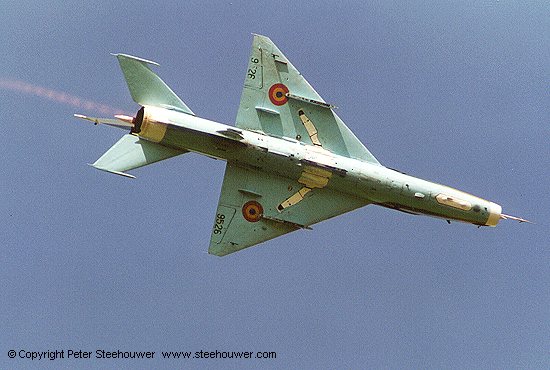 MiG21 B Lancer in Belgium MiG21 B Lancer in Belgium
...impressing the world yet again, 2000
Photo by Peter Steehouwer
|
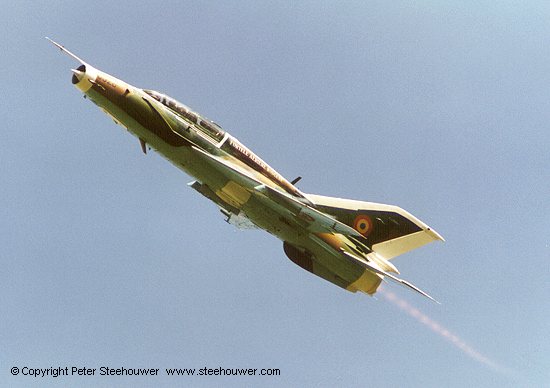 cpt. Cmdr. Dorel Luca cpt. Cmdr. Dorel Luca
...chief of the RoAF MiG-21 Lancer Demo Team at that time, pilot and Cmdr. of the Borcea-Fetesti AFB until the year 2000 is flying this two-seater which was the star of the Air Show in Belgium.
Cpt cmdr Dorel Luca was a guru of the MiG-21. He actually performed acrobatic maneouvres with the MiG-21 which weren't thought possible even by the Russian designers of the jet. He retired in the early 2000's with over 3,000 hrs on the MiG-21.
Photo by Peter Steehouwer
|
Timisoara 2000 Air Show International |
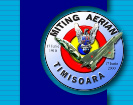
|
|
MiG-21 Lancer Photo Gallery
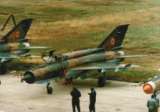 |
 |
 |
 |
| MiG-21 Lancer, Borcea-Fetesti Air Force Base |
MiG-21 Lancer A, at landing |
MiG-21 Lancer, Borcea-Fetesti Air Force Base |
MiG-21 Lancer, awesome cockpit view |
 |
 |
 |
 |
| MiG-21 Lancer A, Mihail Kogalniceanu, during an international exercise with French Alpha Jets |
MiG-21 Lancer A prototype with complete weaponry |
MiG-21 Lancer C with complete weaponry, Expomil 99, Bucharest. You can see the IAR99 Soim at the right corner of the pic
(photo by engr. Danut Vlad) |
MiG-21 Lancer, Borcea-Fetesti Air Force Base |
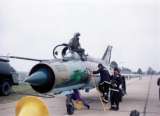 |
 |
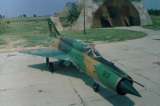 |
MiG-21 Lancer A tail 6001 with lt cmdr Alexandru Manuel Savulescu, Borcea-Fetesti AFB, 2000
Lt Cmdr A M Savulescu crashed and died in that aircraft in february 2002. The jet was completely destroyed.
May he rest in peace |
MiG-21 Lancer C prototype in take-off, Bacau AFB 1997
(photo by engr. Danut Vlad) |
MiG-21 Lancer, Borcea-Fetesti Air Force Base |
|
Lancer at exercises and applications
This section will soon feature a list of some of the many international exercises in which the MiG-21 Lancer had participated.
Until then, here's a small list I've put up together, until I will get the full list, as well as pictures.
Flights in France
(1998)
Exercises with French Alpha Jets
(Mihail Kogalniceanu AFB, Romania, 1998)
Flights in Romania
(with high-ranking NATO officials in the backseat of a Lancer B, 1999)
Exercise with French Alpha Jets
(Mihail Kogalniceanu AFB, Romania, 1999)
Exercise with Dutch F-16AM/BM's
(Mihail Kogalniceanu AFB, Romania, 1999)
Flights in France, 2000
NATO/PfP's "Cooperative Key 2000"
(Mihail Kogalniceanu AFB, Romania, 2000)
NATO/PfP's "Cooperative Key 2001"
(Graf Ignatievo and Krumovo AirBases, Bulgaria, 10-21 september 2001)
03-11 october 2001
Romanian MiG-21 Lancer A, B, C and MiG-29 Fulcrum B and C trained with French updated Mirage F3CT, at Mihail Kogalniceanu AFB, near Constanta (which only one month before has been the scene of the largest airshow ever staged in Eastern Europe, RoIAS 2001).
These are not by far "all" of the exercises and display opportunities in which MiG-21 Lancer's were used to interact with NATO partners, not even an attempt of a "list". I have promises to get the full list, as well as photos, wherever possible, soon.
Lancer Crashes
As I've stated before, no matter the new equipment that has been installed and the reinforcements and modifications of the fuselage, the MiG-21 Lancer is still... a MiG-21. Although the 110 aircraft that have undergone the upgrading process were all made in the late 1970's and still had enough flight resource, the jets were still old. As such, it is of no surprize that many MiG-21 Lancers have crashed in recent years, especially around mid-late 90's and the year 2002 (with no less than three crashes, an absolute record).
I will soon upload a list of the Lancer crashes, with details of every incident.
Other upgrades
MiG-21-93 (from Russia)
The Russians wanted to develop their own upgrade of the MiG-21 and MiG-23, just as they did with the MiG-29, so resulting the MiG-29SMT, MiG-29UDT and the MiG-29UBT Fulcrum.
The Russians installed a new HUD, two monochrome single-function digital displays, replaced a few analogycal panels, representing an affordable upgrade plan for developing nations. The result could be considered as a level two upgrade. On contrast, the Lancer is internationally considered as a post level five upgrade.
MiG21-93 comparisons
 MiG21-93, the Russian upgrade MiG21-93, the Russian upgrade
The Russian media printed false data regarding the Lancer and the MiG-21-93, stating that the latter has a longer radar detection range. They also stated that by that time (the year 2000), 14 Lancers have crashed, killing 8 pilots. The more accurate count until that year is 3 crashes, and no deaths.
Even more so, all the 3 crashes happened due to engine failure, which has nothing to do with the upgrading program, but with, ironically, Russian engines.
|
Coming to the technical data, the Russian engineers displayed on their website a doubtful and truncated radar comparison table. They admitted the table was incomplete, and it ended with a note stating "the other features of the three radar systems are similar". How conveniant. In fact, the detection range for a given RCS target is considerably longer in the Lancer radar, as shown by the figures below.
| |
MiG-21-93 |
MiG-21 LanceR |
| Range |
56 km |
60 km to 80 km |
| Year |
1988 |
1992/1998 |
Now what would you buy, an Israeli radar made in the late 90's, or a Russian radar made in 1988? A radar that has a range between 60 and 80 km, or one with 56 ? Oh I bet you'll buy the Russian radar ! ;)
In addition to the crashes fiasco and the radar fiasco, the two Russian engineers seemed to have forgotten one crucial thing: In their use of the words "project" they 'mistakenly' swapped the Lancer and the 21-93, stating that the Lancer is a "project" while the MiG-21-93 is a "service plane". At that time however, LanceR ceased to be only a "project" and was already an active service aircraft for several years, while the MiG-21-93 remained a project and didn't have any ferm orders yet.
MiG-21-93 did enter service much later, in october 2002, with the Indian Air Force, also the only one to purchase that program. Looking at the Indian military acquisions of the past decade, one could ironically state that they would've purchased it anyway, regardless of the competition, simply because it comes from Russia.
Finally, after inventing 11 crashes and 'killing' 8 Romanian pilots ;), after stating that 56 means more than 60 and 80 (maybe it does, who knows...I just did school in Romania..God knows what they teach us here...), and finally, after mistaking the words project and active service, the two Russian engineers hit the jackpot with their final and most irritating statement. They stated - and this is a good one - that the rest of the Lancer upgrading are "for the comfort of the pilot only".
So now we know that the "east-west" pylons, the helmet-mounted display and firing system (which enables the pilot to fire a missile wherever his eyes can look), the encrypted communications, chaff, flares, and all the rest, are just for "the comfort of the pilot only". Now, I'm really starting to doubt my engineering classes. God, isn't it comfortable to fly a jet ? ;)
Instead of a conclusion...
This page is the largest and most complete MiG-21 Lancer page on the Internet (I checked that out), and one of the largest about the MiG-21 in general. However, in my opinion, it is very very small for such a great fighter and such a daring upgrade. Thus, I can only end it by reminding some of the features that made the MiG-21 such a widely produced fighter, and the LanceR such a successful upgrade: in the 1950's and 1960's, the MiG-21 had a design ahead of its time, tremendous acceleration, fantastic maneouvrability, it was rugged, it could be used both in the jungles of Vietnam as well as in the winters of Siberia, and last but not least, it had the aggressive, determined look which we appreciate so much today. On the other hand, the LanceR upgrade program gave the MiG-21 multiple-weapons loading, higher payload, longer range, higher thrust, higher maneouvrability, more powerful radar, most advanced locking and firing system in the world at that time, the first HMD system in the world until the F-22 entered active service (2006), encrypted communications and new jamming units, more fuel, recon pods, facilities for dive bombing, ...etc etc etc.
The MiG-21 LanceR is still a MiG-21, the airframe is the same, while the engine suffered minor modifications. However, just as long the radar and weapons systems installed onboard will be competitive, just as long the helmet mounted display and firing system will continue to represent the edge of technology, and just as long the Romanian fighter pilots will continue to win international exercises, the MiG-21 Lancer will remain a formidable opponent, often underevaluated by foreign analysts.
Some will argue that they have the best planes in the world and no MiG-21, no matter what it carries onboard, will ever be able to face an F-15, F-18 or F-16 in combat. Well, all those pilots who have flown the Lancer, may they be French, American, Dutch, Belgian or British have been extremely impressed of its performances and the American fighter pilots have stated that the Lancer has real chances to win a dogfight with any of their fighters.
Sorin MiG-21 Fishbed, MiG-21 Mongol and MiG-21 LanceR page is Copyright 1998-2006 by Sorin A. Crasmarelu






















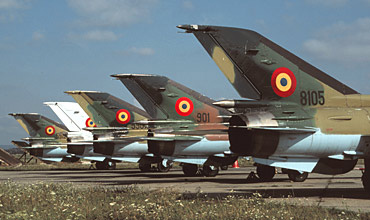

 MiG21 B Lancer in Belgium
MiG21 B Lancer in Belgium cpt. Cmdr. Dorel Luca
cpt. Cmdr. Dorel Luca











 MiG21-93, the Russian upgrade
MiG21-93, the Russian upgrade +1,850 hits for this page since the 27th of March 2001 ? ;)
+1,850 hits for this page since the 27th of March 2001 ? ;)